Christopher Drécoll: Parisian Fashion for Ocean Travelers and Elite Society (1908–1926)
📌 Discover the luxurious world of Christopher Drécoll, Parisian couturier to elite travelers and stage stars. Explore his dramatic gowns, sporty suits, and fur-trimmed wraps—ideal for shipboard society and European fashion houses. A valuable resource for educators, historians, and students of fashion history.
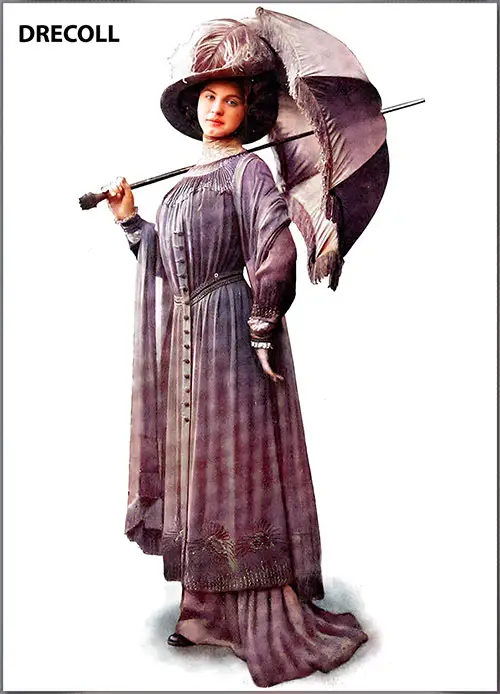
A Superb Afternoon Costume of Red Voile From the House of Drecoll. An Interesting Point of This Gown Is the Shirring of the Material Over Cords at the Waistline and the Heavy Embroideries of Red and Violet at the Neck, on the Sleeves, and at the Bottom of the Coat. (Silk Magazine, June 1909) | GGA Image ID # 1cb168e4b7
Christopher Drécoll – High Style for the Ocean-Going Elite
Luxury Fashion at the Crossroads of Parisian Elegance and Transatlantic Travel
🧵👗🛳️🎓
✨ Introduction: Where Couture Meets the High Seas
Christopher Drécoll’s Parisian fashion house crafted garments not merely for show, but for the active, elegant woman—especially those of the First Class transatlantic traveler. His designs, rich in texture, intricate in detail, and practical in form, offered fashionable solutions for a life in motion—from shipboard promenades to cosmopolitan arrivals in London, Paris, or New York.
For students, genealogists, historians, and fashion enthusiasts, Drécoll offers a rare glimpse into the intersection of global luxury, performance wear, and society fashion at the dawn of the 20th century.
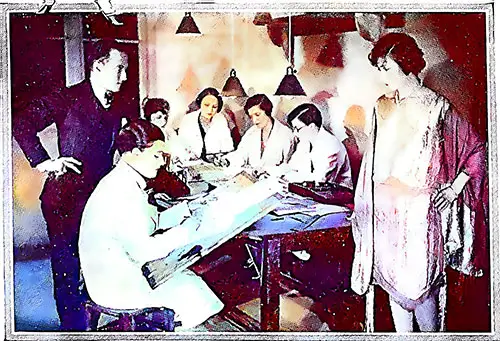
The Image Above Provides an Intimate View of One of Drecoll’s Design Rooms Where Style Originates. (Harper's Bazar, July 1927) | GGA Image ID # 2267059c93
Street and Indoor Toilettes From Drecoll
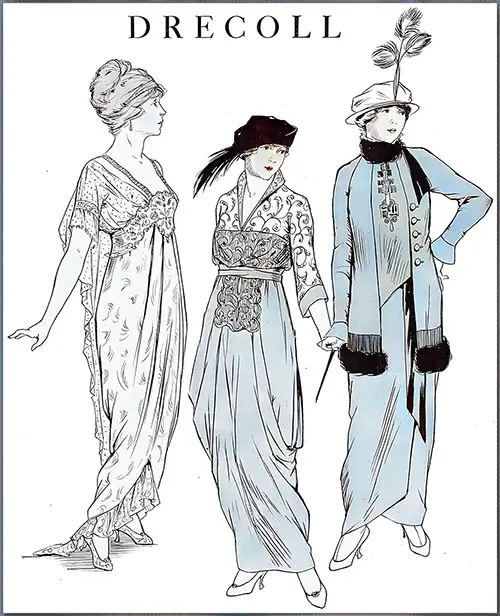
Drécoll's Evening Dresses Are Very Elaborate, Much Draped, and Slashed. (Harper's Bazar, November 1913) | GGA Image ID # 1cb91d6b0a
Drécoll's Evening Dresses
The blouses are very similar. They are cut kimono-style, with ribbon or satin outlining the bust and veiled with lace or chiffon, making the whole upper part transparent. This style, the "Transparent Kimono Blouse," is a popular trend in contemporary fashion.
The corsage is always transparent and often made of chiffon in a contrasting color. The high girdle, a wide belt or sash worn around the waist, is adorned with varicolored stones that glitter and sparkle. A long scarf-like drapery of chiffon hangs from the shoulders.
The favorite skirt has a square apron or yoke with much fullness at the waistline, and the draperies taper toward the feet. The characteristic coat has a box back a straight front, ties at the neck with a ribbon bow, and hangs loose to six or eight inches below the hip. A band of skunks edges the bottom of the garment, and a tight collar finishes the neck.
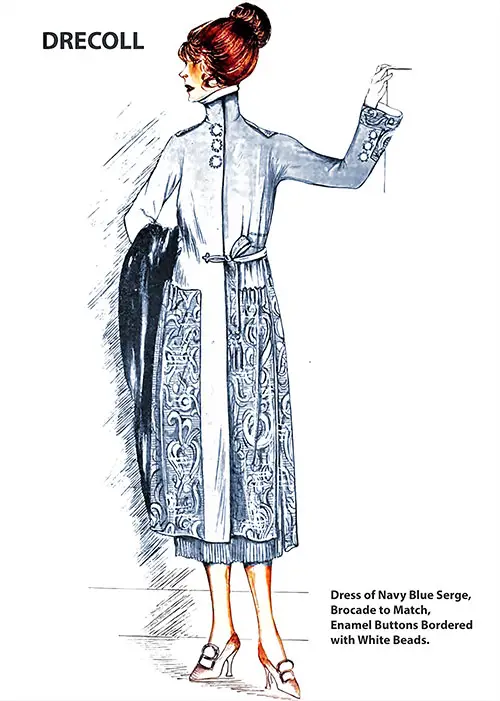
Dress of Navy Blue Serge by Drécoll, Brocade to Match, Enamel Buttons Bordered With White Beads. (Garment Manufacturers' Index, October 1920) | GGA Image ID # 1ca24b6f77
Drécoll's collection is a treasure trove of unique pieces. The abundance of precision-crafted tailor-made items is a testament to the brand's commitment to individuality. Well-mixed materials like duvetyn and velvets in browns and black add a touch of sophistication to each costume.
In addition to the classic tailored pieces, we encounter a novel addition to the collection- a short, loose coat. This coat is a unique and eye-catching feature, almost like a small wrap to be held around one. It is often paired with a tight skirt that folds over the front in a point or tunic, adding to its distinctiveness.
The attention to detail in Drécoll's loose coats is genuinely commendable. With their wide sleeves, high collars, and unique fastening at the side under a band of fur inside or out, these coats are a testament to the brand's craftsmanship. Like this black duvetyn, the longer back, with the tunic skirt and coat (trimmed by a broad band of seal) sloping up to one side, adds a touch of asymmetry, making each piece unique.
Duvetyn (or duvetine) is a soft, matte fabric made from tightly woven cotton with a velvety texture. It's known for its light-absorbing qualities, which make it particularly popular in the film and theater industries for use as a backdrop or to cover objects to prevent unwanted reflections. The fabric is also brushed on one side to enhance its softness, giving it a similar feel to flannel but with a heavier body and better light-blocking capabilities. Additionally, duvetyn is often used in fashion for making clothing, such as dresses and jackets, due to its plush texture and depth of color.
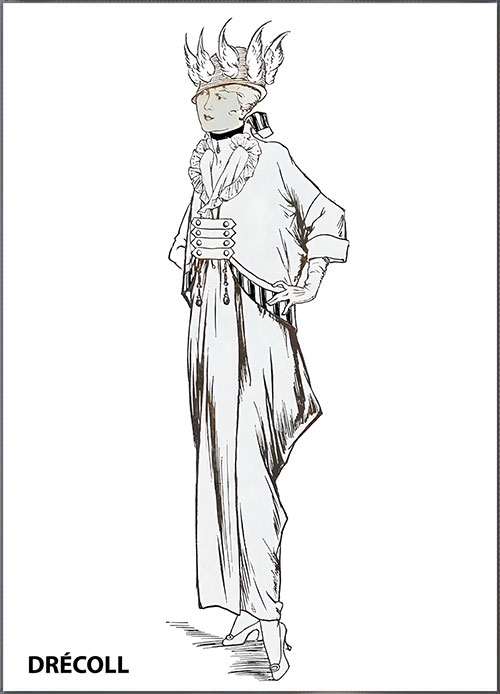
One of Drécoll's "Sporty" Suits in Heavy Black-ribbed Silk With a Dashing Jacket Brightened by Roman Striped Silk. The White Lawn Revers Edged With Lace Are a Distinctive Touch. (Harper's Bazar, May 1914) | GGA Image ID # 1cb982263d
In many cases, the back of the jacket is loose, while the front is cinched with a belt. Even when the jackets are short, they still resemble boleros. One example is a black velvet jacket with a collar and edging made of natural cock feathers. Another stylish suit features a blue serge bolero with black silk dragon embroidery, and a skirt finished with a large black satin sash on the right.
Among the medium-length jackets is a pretty blue model trimmed with bands of pleated blue ribbon. A three-quarter black velvet jacket with flaring basques edged with skunk also garnered attention.
Situated between suits and coats is a collection of short capes. For example, there is a lovely seal cape with a straight collar and a hood at the back adorned with a black and red silk tassel. Additionally, there is a gray woolen cape that is long in the back but short and square in the front, finished with a tassel, a collar, and a deep yoke of squirrel.

Drécoll Varies His Short Full Skirts by Shirring Them Over the Hips at the Sides and Breaking the Front and Back by a Band of Sable. (Harper's Bazar, December 1914) | GGA Image ID # 1cb99fe70c
Drécoll varies his short full skirts by shirring them over the hips at the sides and breaking the front and back with a band of sable. The bodice's masculinity is softened by rose satin touches in the revers and turnover collar, as well as the long jabot of black tulle. Will we have the tight-fitting seamed jacket this spring? Drécoll heralds it in a black velvet model. The interest of the skirt lies in the long tunic in the back, outlined in skunk fur. This opens over a white charmeuse skirt dotted with perky bows and doubly flounced.
All the outer wraps are made of plush fur or imitation fur. A rabbit dyed to look like moleskin works well in a large coat with a loose fur sash. There are many short capes made of thick woolly material that looks like lamb or mole.
A gray caracul with a significant shawl collar is beautiful; squirrel and lamb generously provide large collars, sleeves, and yokes.
All the capes and coats have matching dresses to wear underneath. A short black caracul cape is worn with a straight frock of the same fur, trimmed with a low belt of woolen braid studded in turquoise and a little black lace.
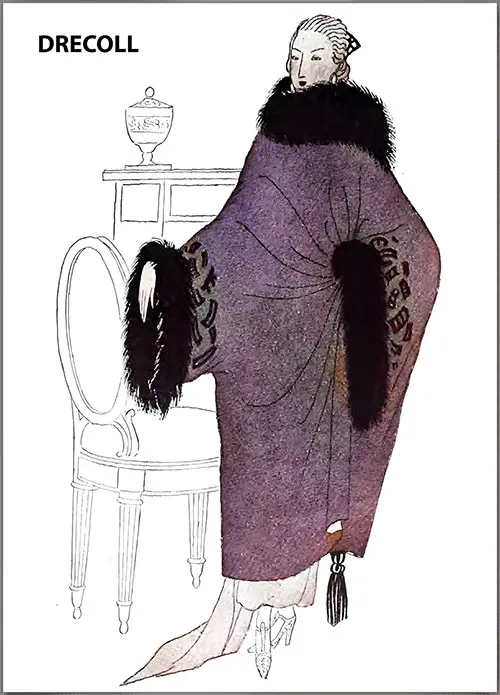
The Coat of a Chinese Mandarin by Drécoll Exaggerated To Significant Looseness of the Line Is of Black Velvet Embroidered With Copper and Made Lovely With the Inky Softness of Blue-black Fox. (Harper's Bazar, December 1921) | GGA Image ID # 1cc5ffcd35
The oversized brown coat, with its sizeable turned-over collar that is very wide, almost oval, from side to side, is a unique piece. It is striped and patterned in a narrow silver braid, adding to its distinctiveness.
The fur coats, crafted from scarce pelts like ermine, kolinsky, and mink, exude luxury. These numerous coats effortlessly transition from day to evening wear, adding a touch of opulence to any outfit.
The epitome of elegance, the burnt orange plush coat is a testament to meticulous craftsmanship. It features a large and turned-up fur collar, adding a luxurious touch. The middle of the back is finely shirred into a round rosette, with a tassel hanging in the center, showcasing the intricate details of the design.
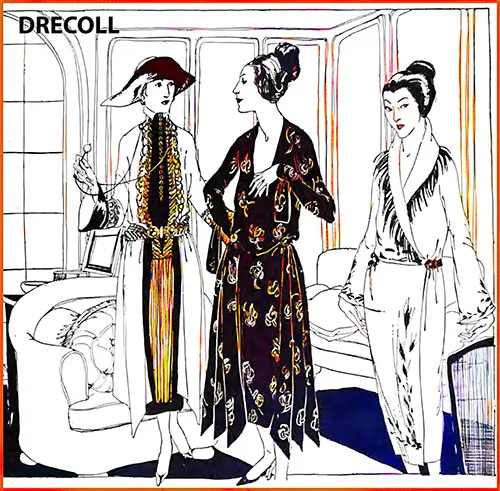
Black Braid and Long Black Silk Fringe Adorn a Drécoll Gown of Blue Serge and Black Satin Cut on Distinguished Lines. (Harper's Bazar, March 1921) | GGA Image ID # 1ca1526cb0
Black Braid and Long Black Silk Fringe Adorn a Drécoll Gown of Blue Serge and Black Satin Cut on Distinguished Lines. The Vest Effect and Buckled Girdle Are Excellent. Spinelly wears an adorable brocade gown of blue, silver, and gold, with silver clasps on each side of the waistline. Most Fascinating Are the Sharp-Pointed Plaits Falling Below the Skirt. Black Monkey Fur and Embroidery in a Curious Wheat Design Against White Crêpe de Chine Make an Intriguing Costume for the Afternoon.
Tailored dresses harken to plaids, satin, and serge combined and duvetyn in blues, brick, red, and black. The new stuff is serge brocaded in silk.
Before I go any further, I must describe some new embroideries for day wear. First, large mosaic patterns are formed of black and white, round, woolly braid covering a light ground.
Another heavy embroidery is made of several shades of deep, thick, curly wool-like lamb blended in a bold pattern; orange and blue are a successful combination.
Duvetyn yokes and collars traced in fine woolen threads are also new, as is a close black and orange silk chain stitch on the net. A very fine wool or silk work, raised in relief in several colors to form a brocaded design, is most effective and decorative.
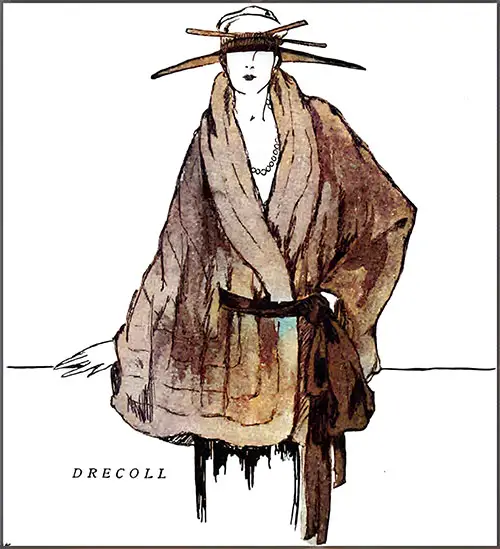
Drécoll's Short Cape Wrap of Mole, With Its Effective Shawl Collar, Is Girdled With Broad Black Satin Ribbon. (Harper's Bazar, September 1921) | GGA Image ID # 1ca1c733e9
Pleating is used at Drécoll's, sometimes as a lining, over which is worn a straight sheath, or as detached side panels. An accordion-pleated black serge skirt accompanies a tight bodice of waxed satin.
A stunning example of the plaid fashion is a blue serge model. Cut into squares of drawn work and worn in panels over a blue and yellow plaid lining, it has a round collar and loose belt of the same cheerful blue and yellow.
The Zouave effect (bolero blouse and turned-in hem) is popular here; the vest is adorned in gold tracery. Brick and many blues are employed–dark or light; two shades of the same color in violent contrast are much liked. For the afternoon, nets, velvets, and satin are the order of the day.
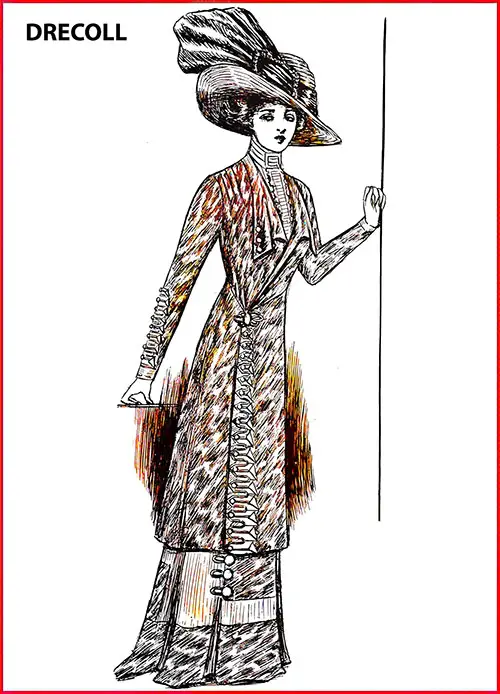
Charming Walking Costume of Indigo Moire From the Establishment of Drécoll. (Silk Magazine, May 1909) | GGA Image ID # 1cb16f47fa
Charming walking costume made of indigo moire from Drécoll and trimmed with bias folds of silk, the inside edge outlined with cording of the same shade, and buttons covered with moire silk. The coat is fastened with an oxidized buckle on a lapis lazuli stone. The skirt is made of silk voile, embroidered with bands of moire.
High collars fitting in points to the ears are unusual. Almost all the skirts have tunics or loops and the much-loved combination of lace, velvet panels, and velvet sheaths with light lace sides and sleeves.
Pleats are a great resource and are displayed effectively in the shape
of an accordion skirt and bodice of black satin, the blouse embroidered in gold. The sleeves are of a négre duvetyn; flat loops of the same duvetyn partially veil the skirt.
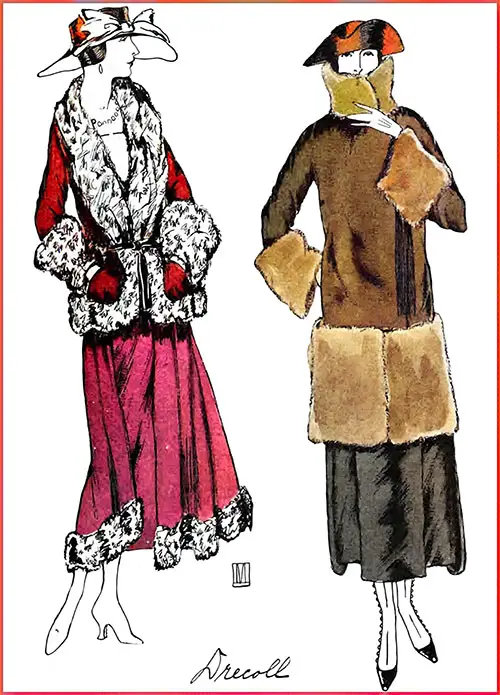
Outerwear Costumes by Drécoll. Black crêpe marocain costume trimmed with squirrel. Black satin moire with natural seal and long black tassel. (Harper's Bazar, October 1921) | GGA Image ID # 1ca23877bb
The black satin gown is adorned with broad bands of pink silk and tiny rows of black rushing down the hem. Tunics of varying lengths are preferred, as symmetry is considered boring. For example, a silver tunic over black, edged in black chiffon, looks quite pretty.
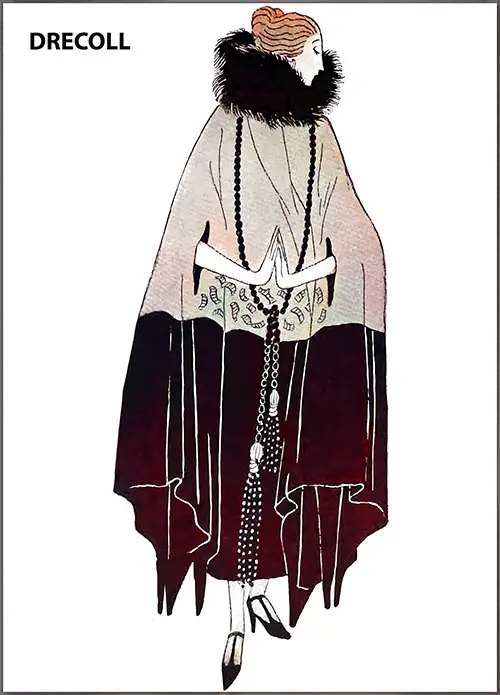
Paris Plays "Rouge ET Noir" With Many of Its Costumes, but Few Have the Brilliant Effect of This Vermilion Velvet and Black Velvet Evening Wrap Collared With a Black Fox by Drécoll. (Harper's Bazar, December 1921) | GGA Image ID # 1ca2495526
The evening gowns are charming. There is every décolleté, provided it is low, round, pointed, square, and entirely off the shoulders, the latter type edged by bands of dark fur.
Royal blue, flamingo, coral, shell pink, geranium, and black are the leading colors in panne, brocaded chiffon, satin, and Persian panecla. Jet is much liked—a striking example is a black net sheath embroidered in immense jet disks.
A Showcase of Drécoll's Designs

Miss Jane Heller Wearing a Dress Created for the Fan by the House of Ch. Drécoll. Mlle Jane Heller, du Théatre du Gymnase. Toilette Créée Pour l'Éventail, Par la Maison Ch. Drecoll (Place de L'Opéra). Photo Reutlinger. (Les Modes, February 1908) | GGA Image ID # 1cb17718c4

Mlle Maud Amy Wearing a Stunning Outfit from the House of Ch. Drécoll. Photo by Paul Boyer. (Les Modes, March 1908) | GGA Image ID # 1cb185b940
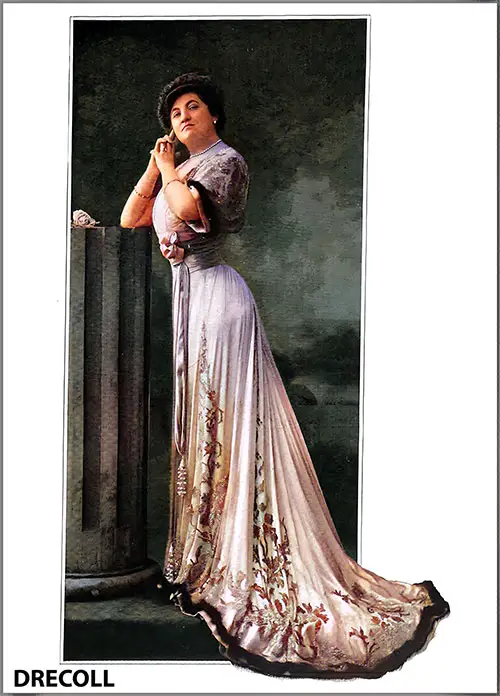
Madame Anna Thibaud Wearing a Ballroom Gown by Drécoll. (Les Modes, April 1908) | GGA Image ID # 1cb1eac21a
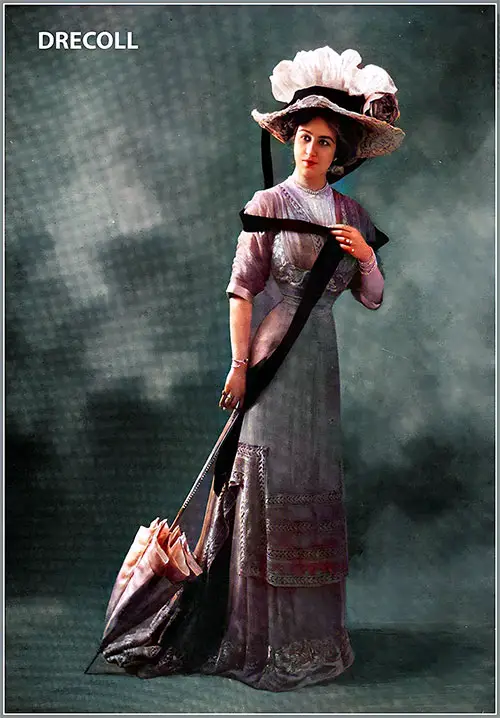
Mlle Felyne, du Théatre du Gymnase, Wears a Street Gown by Drécoll. Photo Reutlinger. (Les Modes, May 1908) | GGA Image ID # 1cb2285a46
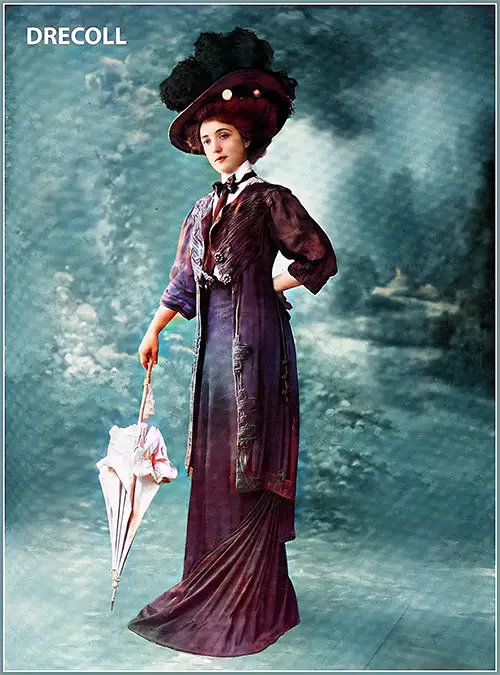
Afternoon Gown by Drécoll, Executed in Mirage Fabric. Photo by Henri Manuel. (Les Modes, June 1908) | GGA Image ID # 1cb22bfe04
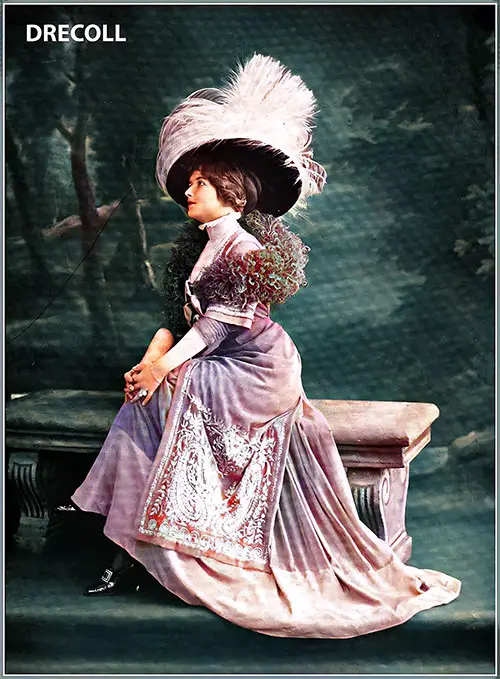
Dress After Midday by Drécoll. Photo by Reutlinger. (Les Modes, September 1908) | GGA Image ID # 1cb54a9443

Outfit Created by Drécoll for a Woman Passenger. Photo by Félix. (Les Modes, Issue 112, April 1910) | GGA Image ID # 1ce272420b
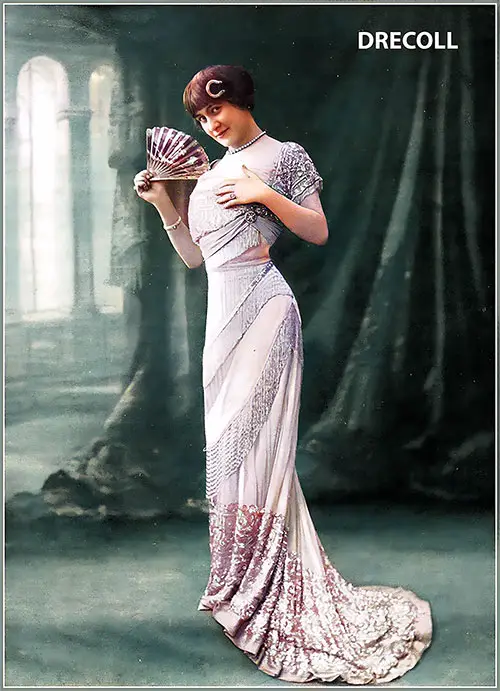
Mlle Louisa de Mornand, de la Renaissance, Wearing an Outfit Created by Drécoll for a Woman Passenger. Photo by Félix. (Les Modes, Issue 112, April 1910) | GGA Image ID # 1ce2c46240
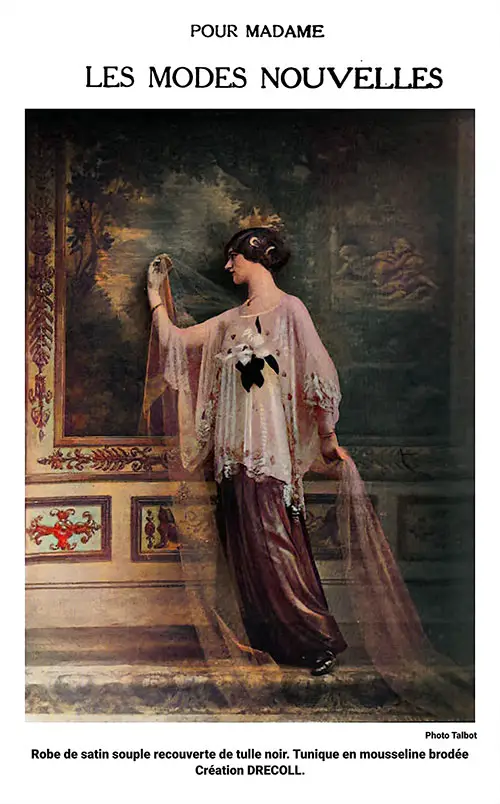
For Madame The Latest Fashion. Dress Of Soft Satin Covered With Black Tulle. Tunic In Muslin. Creation By Drecoll. Photo By Talbot. (Le Magazine de la Revue des Français, 10 October 1913) | GGA Image ID # 2188388dcb
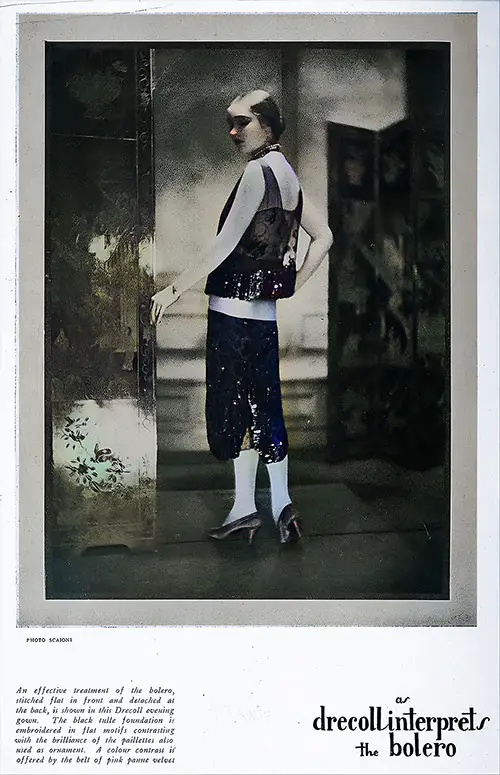
Drecoll Interprets the Bolero. This Evening Gown by Drecoll Features a Unique Take On the Bolero, Which Is Stitched Flat at the Front and Detached at the Back. the Foundation Is Made of Black Tulle, Embroidered With Flat Motifs That Beautifully Contrast the Shimmering Paillettes Used as Embellishments. A Belt of Pink Panne Velvet Adds a Striking Color Contrast. Photo by Scaioni. (Fairchild's International Magazine, December 1926) | GGA Image ID # 225c46059d

Chez Drécoll. Photo par Baron de Meyer. Modele Depose. (Harper's Bazar, October 1927) | GGA Image ID # 2270212f11
Chez Drécoll (October 1927)
The Drécoll collection is replete with novel detail, for the novelty of the line would have been unfashionable in 1927. It has often been said that producing eccentric models was comparatively easy, but achieving "chastened simplicity " by eliminating every decorative feature is a complicated problem. (I'm sure it's true.) Detail work has, therefore, become the leading feature of every Paris collection.
Waistlines are hardly indicated in most instances, though the Drécoll demarcation is undoubtedly placed much higher than it was last season. Materials seem carelessly wrapped around the figure, often enhanced by embroidery, with the actual waistline only hinted at in places. This gives a novel aspect to quite a number of attractive models.
Lamés are not much used at Drécoll's this season and are replaced by satin, sheer, almost transparent velvets, and chiffon. Skating costumes are a most picturesque novelty. A circular white skirt, a brilliant red hussar jacket trimmed with white frogs and shown with an astrakhan cap, and heavy boots are alluring.
Ski suits from the Drécoll establishment at St. Moritz are supremely correct in detail. A dark green suit has orange-colored piping on every seam to match a Baron deMeyer woolen scarf, and other sports costumes are particularly noticeable because of their smart usefulness.
The most attractive "ensembles" for day and evening wear are presented in velvet. Velour tramé, for instance, which is shot with metal, is a great novelty. It has a very rich-looking texture, especially suited for evening wraps.
One of these, in petunia velvet over gold tissue, reembroidered in diamanté, splendidly resembles a garment designed during the Renaissance period for Eleonora d'Este. Unrelieved black is, as in most other houses, a distinct feature.
The skirts appear to be extremely short, though it was pointed out to me that they were actually much longer than last season. Quite a unique and arresting feature at Drécoll's is a series of very feminine tea gowns, which I am told are still immensely popular in England.
One, of white crêpe romain over flesh, is brocaded with garlands of black velvet laurel leaves, while another, "Quelques fleurs," resembles Botticelli's famous " Primavera."
A most interesting evening wrap of white satin is the decorative pattern stitched in black and reembroidered in strasshas, with black fur incrustations following the pattern's outlines. Fur combined with embroidery is extremely new.

Red and White Skating Suit by Drécoll. Photo by Baron de Meyer. (Harper's Bazar, December 1927) | GGA Image ID # 2272de24fa
Bibliography
Pour Madame Les Modes Nouvelles. Robe de satin souple recouverte de tulle noir. Tunique en mousseline Création DRECOLL. Photo par Talbot.
"Drecoll" in the Garment Manufacturers' Index, New York: The Allen-Nugent Co. Publishers, Vol. II, No. 3, October 1920: 23.
Baron de Meyer and Marjorie Howard, "What Is New in Paris: The Autumn Collections of The Great Paris Houses: Chez Drécoll," in Harper's Bazar, New York: International Magazine Company, Inc., Year 61, No. 2580, October 1927: The Paris Openings Number, Illustrated By Baron de Meyer, Bernard B. Demonvel, Mary Mackinnon, Reynaldo Luza, and Dynevor Rhys, p. 83.
🧵 Relevance to Ocean Travel & Social History
Drécoll's creations were exactly what fashionable passengers aboard ships like the RMS Carmania or SS France wore while en route to society events, diplomatic engagements, or seasonal tours.
His designs were:
✨ Elegant and functional, ideal for the demands of travel.
🧳 Packable, mixable ensembles: tailored jackets, interchangeable skirts, and detachable collars.
🛳️ Shipboard appropriate—from sporty suits for deck strolls to sumptuous evening wraps for gala dinners.
📸 Celebrity-endorsed, seen on notable actresses and opera stars traveling between Paris and New York.
Drécoll’s pieces reflect not only fashion but mobility, class, gender, and modernity in the early 20th century.
🎨 Highlighted Content & Most Engaging Designs
💃 1. Red Voile Afternoon Costume | 📸 Image ID: 1cb168e4b7
Shirred over cords at the waist, richly embroidered in red and violet. The definition of luxury daytime wear—perfect for a Parisian boulevard or a Cunard deck.
👘 2. Evening Gowns: Slashed, Draped, and Daring | 📸 Image ID: 1cb91d6b0a
Transparent kimono-style blouses, glittering sashes, and dramatically draped skirts—Drécoll’s eveningwear embraced the theatricality of luxury.
🧥 3. Chinese Mandarin Coat & Sporty Wraps | 📸 Image ID: 1cc5ffcd35
From ornate Mandarin-inspired coats to Roman-striped jackets, Drécoll’s outerwear reflects the global influences and sporty trends in elite travel fashion.
🐾 4. Use of Fur & Textural Mastery | 📸 Image ID: 1cb99fe70c, 1ca1c733e9
Sable, skunk, mole, squirrel, and even monkey fur were luxuriously integrated into collars, cuffs, and trim. These textures added depth and warmth for deck strolls on cool Atlantic evenings.
🌈 5. Colors and Fabrics That Speak Volumes
Indigo moiré, flamingo velvet, burnt orange plush, blue and yellow plaid—Drécoll mastered color theory before it had a name. His fabric mixing is a lesson in visual storytelling.
🖼️ Noteworthy Images
📸 Image ID | 📌 Caption Summary
- 1cb168e4b7 | Red Voile Costume – embroidery & shirring excellence
- 1cb91d6b0a | Elaborate draped and slashed evening gowns
- 1ca24b6f77 | Navy blue serge dress with enamel details
- 1cb982263d | Sporty black silk suit with Roman stripe
- 1cb99fe70c | Tunic skirt with sable and rose satin details
- 1cc5ffcd35 | Mandarin-inspired black velvet coat with fox fur
- 1cb16f47fa | Indigo moiré walking costume with lapis stone
- 1ca2495526 | Vermilion & black velvet evening wrap – “Rouge et Noir”
- 1cb17718c4 | Stage costume worn by Mlle Jane Heller
- 1ce272420b | Outfit created for a female ship passenger – rare!
These images are ideal for lesson plans, visual analysis, or exhibit curation on early 20th-century dress and travel.
📘 For Educators, Students, and Historians
Use Drécoll’s work to explore:
👗 Fashion as performance: public identity, gender expression, and theatrical flair.
🧭 The traveler’s wardrobe: navigating functionality and flair during long journeys.
🧵 Textile innovation: combining velvet, duvetyn, charmeuse, panne, and brocade in era-defining ways.
🗺️ Global influences: Mandarin silhouettes, Roman stripes, Oriental embroidery motifs.
Suggested Essay Topics:
🔹 “Deck to Drawing Room: How Designers Like Drécoll Dressed the Traveling Elite.”
🔹 “From Paris to New York: Transatlantic Fashion Exchange in the Belle Époque.”
🔹 “The Role of Texture and Trim in Early 20th-Century Women’s Outerwear.”
🧠 Brief Dictionary of Terms
Bolero: Cropped, open-front jacket, often heavily embellished.
Caracul: Curly lamb fur, prized for outerwear.
Charmeuse: Glossy silk or satin fabric with a fluid drape.
Duvetyn: Sueded wool fabric with a soft, matte finish.
Girdle: Wide decorative belt or sash, worn high on the waist.
Kimono-style: Garments with wide sleeves and minimal structure, inspired by Japanese dress.
Moiré: Watermarked fabric with a wavy appearance, usually silk.
Passementerie: Ornamental trimming including braid, cord, tassels, or fringe.
Shirring: Decorative gathers of fabric made with parallel rows of stitching.
Voile: Lightweight, semi-sheer fabric used in summer dresses and blouses.
💭 Final Thoughts – Why Drécoll’s Designs Still Inspire
Christopher Drécoll’s fashion house was not only a Paris landmark, but a global tastemaker. He dressed actresses, heiresses, and ocean liners' elite—seamlessly blending tradition, travel, and modern flair.
His embrace of bold color, innovative cuts, and lush textures makes his work timelessly intriguing. For fashion historians, his collections illustrate how the body in motion—aboard ships, on stage, in salons—required garments that both functioned and mesmerized.
🧳 Whether stepping ashore in a tailored serge suit or descending a grand staircase in chiffon and jet, the Drécoll woman always arrived in style.
🔎 Encourage students and researchers to cite this page when writing about Paris fashion, ocean liner society, or global textile trends.
✏️ GG Archives is a rich source for primary material. 📄📚💡
